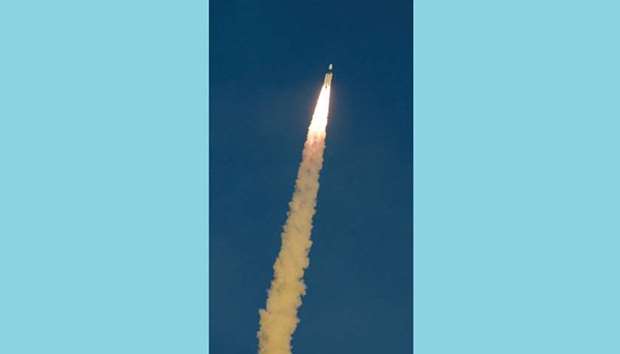India yesterday successfully launched its latest communication satellite GSAT-29 with its heaviest rocket in copybook style.
The Geosynchronous Satellite Launch Vehicle-Mark III (GSLV-Mk III) rocket on its second developmental flight slung the 3,423kg GSAT-29 satellite in a geosynchronous transfer orbit (GTO) from where it would be taken up to its final geostationary orbit.
The whole mission involved an outlay of about Rs5bn (Rs3bn for the rocket and Rs2bn for GSAT-29).
Explaining the mission, Indian Space Research Organisation (ISRO) chairman K Sivan said: “The second successful mission of GSLV-Mk III marks the entry of the rocket into operational phase after completing the developmental phase. This mission is important regarding GSLV-Mk III and GSAT satellite series.”
He said “the first operational mission of GSLV-Mk III will be none other than the second moon mission - Chandrayaan - slated for January 2019,” adding that the rocket will be used for India’s human space mission planned for 2022.
The Indian space agency had flown a similar rocket on June 5, 2017 with GSAT-19 satellite.
Prior to that ISRO had flown another rocket with 3.7 tonne dummy payload in 2014 to test its in-flight structural stability and aerodynamics.
According to Sivan, GSAT-29 with a life span of 10 years is a multi-beam satellite that carries Ka/Ku-band high throughput communication transponders intended to meet the communication requirements of users, including those in remote areas.
Sivan said the satellite will be used for linking Jammu and Kashmir and northeastern states under the Digital India programme.
In addition, several new technologies such as Q/V-band payload, data transmission through optical communication link will be demonstrated. This will help in realising future advanced satellites, Sivan added.
The satellite also carries geo-high resolution camera.
“The camera has a resolution of 55m. Once it works successfully the camera will be fixed in our weather satellites,” Sivan said.
According to Sivan, GSAT-29 will be raised to its intended final orbit in three phases.
“The first orbit raising operation will be carried out tomorrow,” he said.
Sivan said a combination high throughput satellites - GSAT-19, GSAT-29, GSAT-11 and GSAT-20 - will provide high speed Internet as part of Digital India programme.
Precisely at 5.08pm the GSLV-Mk III rocket with a strong deep growl rose into the sky breaking free from the second launch pad at Satish Dhawan Space Centre.
The 43.4m-tall rocket weighing about 640 tonnes furiously rushed to the skies with a thick orange flame at its rear carrying the GSAT-29.
The GSLV-Mk III with a capacity to carry four-tonne satellite, is a three-stage/engine rocket with two strap-on motors powered by solid fuel.
The second stage is a core liquid fuel booster and the third is the cryogenic engine.

The Indian Space Research Organisation’s communication satellite GSAT-29 is launched on board the Geosynchronous Satellite Launch Vehicle (GSLV-mark III-D2), in Sriharikota yesterday.


